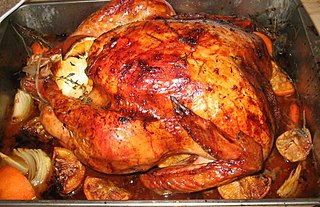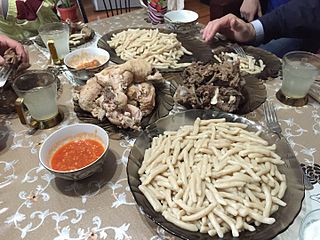Related Research Articles

Turkish cuisine is largely the heritage of Ottoman cuisine, which can be described as a fusion and refinement of Mediterranean, Balkan, Middle Eastern, Central Asian, Eastern European, Armenian, and Georgian cuisines. Turkish cuisine has in turn influenced those and other neighbouring cuisines, including those of Southeast Europe (Balkans), Central Europe, and Western Europe. The Ottomans fused various culinary traditions of their realm with influences from Mesopotamian cuisine, Greek cuisine, Levantine cuisine, Egyptian cuisine, Balkan cuisine, along with traditional Turkic elements from Central Asia, creating a vast array of specialities.

Hungarian or Magyar cuisine is the cuisine characteristic of the nation of Hungary and its primary ethnic group, the Magyars. Traditional Hungarian dishes are primarily based on meats, seasonal vegetables, fruits, bread, and dairy products.

Pudding is a type of food that can be either a dessert or a savoury dish that is part of the main meal.
The Albanian cuisine is a representative of the cuisine of the Mediterranean. It is also an example of the Mediterranean diet based on the importance of olive oil, fruits, vegetables and fish. The cooking traditions of the Albanian people are diverse in consequence of the environmental factors that are more importantly suitable for the cultivation of nearly every kind of herbs, vegetables and fruits. Olive oil is the most ancient and commonly used vegetable fat in Albanian cooking, produced since antiquity throughout the country particularly along the coasts.

The jackfruit, also known as jack tree, is a species of tree in the fig, mulberry, and breadfruit family (Moraceae). Its origin is in the region between the Western Ghats of southern India, all of Sri Lanka and the rainforests of Malaysia, Indonesia and the Philippines.

Fruitcake is a cake made with candied or dried fruit, nuts, and spices, and optionally soaked in spirits. In the United Kingdom, certain rich versions may be iced and decorated.

Rice pudding is a dish made from rice mixed with water or milk and other ingredients such as cinnamon, vanilla and raisins.
Latvian cuisine typically consists of agricultural products, with meat featuring in most main meal dishes. Fish is commonly consumed due to Latvia's location on the eastern shore of the Baltic Sea.

Kalduny or kolduny are stuffed dumplings made of unleavened dough in Belarusian, Lithuanian, and Polish cuisines, akin to the Polish pierogi, Russian pelmeni and the Ukrainian vareniki.

Christmas dinner is a meal traditionally eaten at Christmas. This meal can take place any time from the evening of Christmas Eve to the evening of Christmas Day itself. The meals are often particularly rich and substantial, in the tradition of the Christian feast day celebration, and form a significant part of gatherings held to celebrate the arrival of Christmastide. In many cases, there is a ritual element to the meal related to the religious celebration, such as the saying of grace.

An apple dumpling is a baked or boiled pastry-wrapped apple. To prepare apple dumplings, apples are peeled, cored and sometimes quartered and placed on a portion of dough. The hole from the core may be filled with cinnamon, butter and sugar and sometimes dried fruit such as raisins, sultanas, or currants. The dough is folded over the apples and sealed. Sometimes a spiced sauce is poured over the dumplings which are then baked until tender; the sugar and butter create a sweet sauce. Apple dumplings can be served hot, cold, or room temperature for breakfast, dessert, or as a main dish.
Armenian cuisine includes the foods and cooking techniques of the Armenian people and traditional Armenian foods and dishes. The cuisine reflects the history and geography where Armenians have lived as well as sharing outside influences from European and Levantine cuisines. The cuisine also reflects the traditional crops and animals grown and raised in Armenian populated areas.

Nepali/Nepalese cuisine comprises a variety of cuisines based upon ethnicity, soil and climate relating to Nepal's cultural diversity and geography. Dal-bhat-tarkari is eaten throughout Nepal. Dal is a soup made of lentils and spices, served over boiled grain, bhat—usually rice but sometimes another grain - and a vegetable soup, tarkari. Condiments are usually small amounts of spicy pickle which can be fresh or fermented, and of which there are a considerable number of varieties. Other accompaniments may be sliced lemon (nibuwa) or lime (kagati) with fresh green chilli and a fried papad. Dhindo (ढिंडो) is a traditional food of Nepal.

Hoşaf is a Turkish dessert made of dried fruits like raisins, dried prunes, apricots, figs boiled in water with some sugar and left to cool. Hoşaf may also contain cinnamon or cloves.
A suet pudding is a boiled, steamed or baked pudding made with wheat flour and suet, often with breadcrumb, dried fruits such as raisins, other preserved fruits, and spices. The British term pudding usually refers to a dessert or sweet course, but suet puddings may be savoury.

Fruit preserves are preparations of fruits whose main preserving agent is sugar and sometimes acid, often stored in glass jars and used as a condiment or spread.

Sharbat is an Iranian drink also popular in Turkey, South Asia, Caucasus and the Balkans. It is prepared from fruits or flower petals. It is a sweet cordial, and usually served chilled. It can be served in concentrated form and eaten with a spoon or diluted with water to create the drink.

A hingel is a type of dumpling found in North Caucasus that is similar to manti. The meat version of the dish is often associated with the Turkish province of Çorum but there is a potato stuffed variety said to hail from Erzurum in eastern Anatolia. The meat stuff variety resembles a larger than average Turkish manti, but unlike manti, the filling includes onion, garlic and parsley as well as ground meat. It is served with a sauce of melted butter and yogurt.
Şıllık is a Turkish dessert crepe that is a specialty of the southeastern Urfa province. It is a thin dough made of milk and flour, similar to a crepe, filled with ground walnuts and topped with simple syrup and chopped pistachio. Some versions of the filling may include a mix of walnut and pistachio. Butter or Turkish grape molasses may optionally be added to the simple syrup sauce. Traditionally, lamb tail fat was used to fry the crepes. In Turkish the word şıllık means slut or hussy, so some women in the conservative province of Urfa are not comfortable ordering the dessert by name, preferring instead to allow a male relative to order it for them or simply asking for "that dessert".
References
- 1 2 "Pilav yanında Kaysefe/Yöresel Yemekler/milliyet blog". blog.milliyet.com.tr. Retrieved 2018-11-08.
- ↑ Kristbergsson, Kristberg; Oliveira, Jorge (2016-03-09). Traditional Foods: General and Consumer Aspects. Springer. ISBN 978-1-4899-7648-2.
- ↑ "Turgay Başyayla İle Lezzet Yolculuğu 179.Bölüm / Erzurum - YouTube" . Retrieved 2018-11-08.